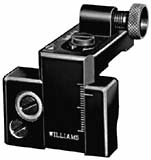|
Williams 5D Receiver Sight By Chuck Hawks  The Williams Gunsight Company, Inc. has been around a lot longer than I have, which is saying something. Their products have always been well respected. The latest Williams sight innovation is the famous Fire Sight, which is taking over the upscale open sight market. In addition to Fire Sights for a wide variety of rifles, shotguns and handguns, Williams continues to offer their traditional receiver (peep or aperture) sights. These include the deluxe micrometer adjustable "Foolproof" Model FP and the simpler and less expensive 5D hunting model. Both are available for a wide variety of rifles, both current and discontinued models. The receiver sight offers a simpler and more accurate sight picture than standard open sights. The eye looks through the aperture, also sometimes called a ghost ring because it is blurry, making no attempt to focus on the rear sight. Focus is required only for the front sight and target. The eye will automatically peer through the center of the aperture without conscious thought. The militaries of practically all major powers adopted the aperture sight before the beginning of World War II, testament to its simplicity, durability, and performance. And the rear aperture sight remains the standard aiming system for military rifles around the world. Today, the aperture sight is not as common on hunting rifles as it once was. Telescopic sights, which put the target and aiming mark in a single sighting plane, have become the preferred sighting system for most hunting rifles. The aperture sight still has its place in the scheme of things. It is very fast to align and does not block the shooter's view of the lower half of the target, as does an open rear sight. The sight itself may be removed from its base and kept in reserve, leaving room for a low mounted scope in a quick detachable mount. This makes receiver sights a popular option with a good many African hunters, especially those who occasionally use their plains rifles to hunt dangerous game at close range. Another popular application is on pre-angle eject Model 94 Winchesters. These are outstanding woods rifles, but they are awkward to scope. And a scope interferes with carrying them in one hand, grasped around the receiver. A receiver sight solves both of these problems and is far superior to the open sights supplied with the rifle. Thus it is that the specific model of Williams receiver sight chosen for this review is the 5D-94/36, mounted on a pre-angle eject Model 94 Winchester .30-30 rifle. The Williams 5D-94/36 sight is manufactured from black anodized aluminum alloy and is supplied with steel screws. To adjust the elevation of the sight, loosen the side friction screw and turn the elevation screw in or out with a small screwdriver. The elevation screw also serves as a stop screw, permitting the sight to be removed from its base and returned without changing its zero. To adjust windage, loosen the dual clamp screws and gently slide the aperture left or right the desired amount. There are a series of white index marks for both the elevation and windage settings, which make the adjustment process simpler and more accurate. The supplied aperture disc is a good compromise for general purposes. For an extra wide field of view, simply remove the aperture disc and sight through the resulting large opening. Pre-angle eject Winchester Model 94 rifles were drilled and tapped for receiver sights, so all the user has to do is mount the sight base to the left side of the receiver, using the two provided screws, and slide the sight into the base. Practically anyone can accomplish this simple chore in mere minutes. The hardest part of the whole operation is removing the original rear sight from its dovetail grove so that it does not interfere with the new receiver sight. A hammer and a brass or hardwood drift pin is recommended for this chore. Several manufacturers offer folding leaf rear sights that will clear the receiver sight when folded and can be used to fill the empty dovetail if desired. This is purely a cosmetic choice, as the empty dovetail does no harm. Once the 5D aperture sight has been mounted on the rifle and bore sighted, it is ready to be sighted-in at the range. I recommend starting at 25 yards to make sure that the bullets at least hit the paper. Get the sight set dead on at 25 yards, and then move back to 100 yards for final adjustment. The "Rifle Trajectory Table for Iron Sights," which can be found on the Tables, Charts and Lists Page, has trajectory information for most common calibers and loads. I found the elevation adjustment to be easier to use and more precise than the windage adjustment, but overall the 5D was easy to zero-in. Its advantage is that when all three of the friction lock screws are tight, the settings are very secure and unlikely to be inadvertently changed. It is a good sight for rough conditions, perhaps better than the more expensive Lyman and Williams micrometer adjustment receiver sights. In the case of a .30-30 Winchester rifle shooting a 150 grain bullet at a MV of 2390 fps, the load I was using in the test rifle, set the sights to put the bullet 2.9" high at 100 yards. The maximum point blank range (+/- 3") is then 218 yards, which I would consider more than adequate for any iron sighted rifle. The Williams 5D receiver sight is clearly superior to the cheap open sights supplied with most rifles. And the proof is in the shooting. The 5D rear sight cut my 100 yard group size about in half compared to the original semi-buckhorn open rear sight, a tremendous improvement for the very modest (in 2004) online retail price of about $37. |